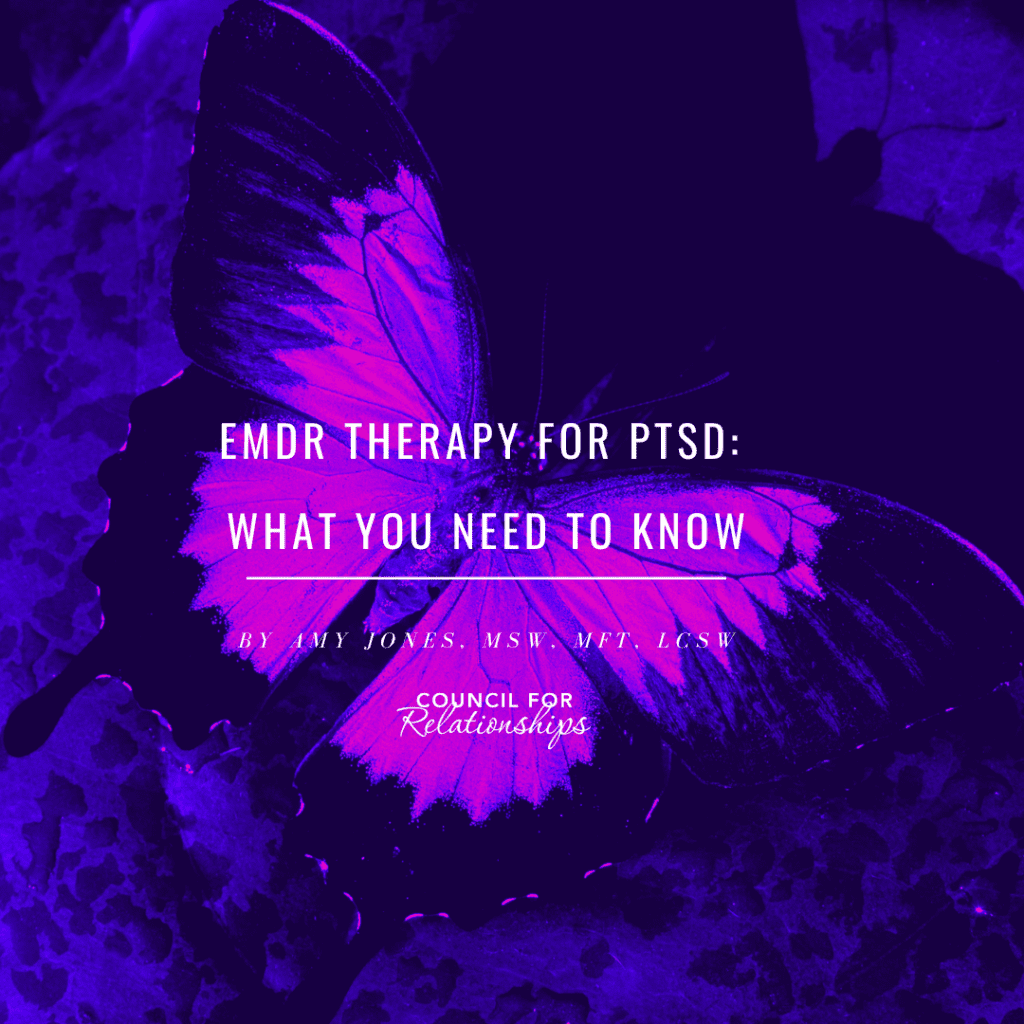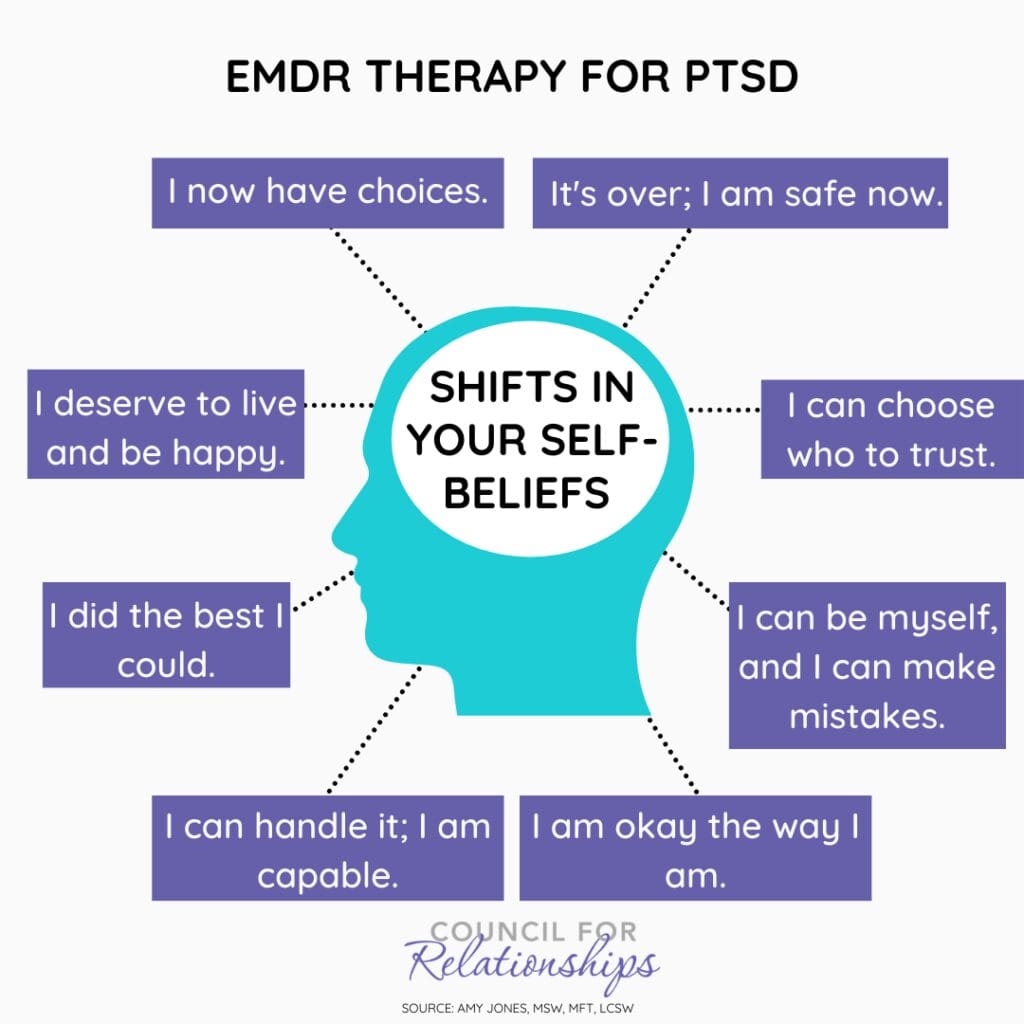EMDR Therapy for PTSD: What You Need to Know
Amy Jones, a therapist at the Council for Relationships, first trained in Eye Movement Desensitization and Reprocessing Therapy (EMDR) in 2021. She quickly fell in love with EMDR therapy for Post-Traumatic Stress Disorder (PTSD) due to its effectiveness in shifting traumatic memories for both herself and her clients. This blog outlines the signs of PTSD and provides insights on how EMDR therapy for PTSD can help individuals heal from traumatic experiences.
In this blog, you will learn about…
- The symptoms of PTSD
- The theory behind EMDR therapy for PTSD
- How this therapeutic approach can help reprocess traumatic memories
- How to access EMDR services at Council for Relationships
I first trained in EMDR in 2021 and fell in love with it while taking the basic training. I was amazed at how the process shifted my own traumatic memories and those of my clients, and it has since become one of the very valuable tools that I use as a therapist.
In this spirit, here are signs of PTSD that you can be aware of if you have experienced a traumatic event, along with more information on how EMDR therapy for PTSD can help.
 What is EMDR Therapy for PTSD?
What is EMDR Therapy for PTSD?
EMDR is one of the models of therapy used to treat PTSD and other disorders that can result from experiencing trauma (for example, mood disorders such as depression and anxiety disorders) recently or anytime during your life, even including an infant or young child.
The theory behind EMDR therapy for PTSD states that a traumatic event or ongoing traumatic experiences overwhelm the brain and body, causing symptoms of PTSD and other disorders. When trauma overwhelms the brain, it cannot process these events like everyday occurrences, isolating and blocking memories from adaptive networks in the brain. This means that the brain and body experience the present day as if the past traumatic event is still happening, constantly trying to respond to and process these unresolved experiences.
Individuals with PTSD might experience mental flashbacks to the traumatic events, anxiety about the future, and nightmares related to the trauma. They may shut down or feel disconnected from their bodies, have trouble with memory and sleeping, and exhibit heightened alertness, being on edge, jumpy, or restless. Intrusive thoughts can plague them, often coupled with feelings of powerlessness, helplessness, worthlessness, defectiveness, brokenness, or being overly responsible.
Everyday tasks can become challenging, with simple activities feeling insurmountable—such as forgetting things frequently or having difficulty deciding what to wear or cook. They may also have overly intense emotional reactions or outbursts, particularly when reminded of the past traumatic event by something in the present.
EMDR therapy for PTSD employs the support of a trained, nonjudgmental therapist to help individuals focus on the most distressing part of a traumatic memory or experience. The therapist uses various types of Bilateral Stimulation (BLS) to help the brain and body desensitize these memories so they are no longer overwhelming and to reprocess them so they can connect with the brain’s adaptive networks.
BLS methods may include guiding the individual to follow the therapist’s fingers moving back and forth, mimicking the Rapid Eye Movement (REM) phase of sleep, tapping their knees alternately, or using the butterfly hug technique where the individual crosses their hands over their chest and taps each side under the clavicles alternately. These techniques help to get the memories “unstuck” and integrated with the brain’s adaptive information processing system, promoting healing and reducing the symptoms of PTSD.

Infographic by Council for Relationships
EMDR & Memory Challenges
After undergoing EMDR therapy for PTSD and successfully desensitizing and reprocessing traumatic memories, you may experience several significant changes. One of the primary changes is not feeling any distressing emotions or sensations in your body when thinking about the traumatic memory. The memory itself may feel more distant and less vivid, losing its power to cause emotional upheaval.
Another notable change is the shift in your self-beliefs. You might start to believe more adaptive and positive thoughts about yourself. For instance, you may think, “It’s over; I am safe now,” or “I can choose who to trust.” Other empowering beliefs might include, “I can be myself, and I can make mistakes,” “I am okay the way I am,” and “I can handle it; I am capable.”
You might also find yourself thinking, “I can trust myself and my judgment,” “I did the best I could,” “I deserve to live and be happy,” and “I now have choices.” These thoughts reflect a healthier, more positive self-image and a greater sense of control over your life and choices.
Accessing EMDR Therapy for PTSD at Council for Relationships
Many therapists at Council for Relationships (CFR) have trained and/or certified in EMDR therapy for PTSD. Recently, I was part of a group of EMDR CFR therapists, including Dr. Sara Corse, Florda Priftanji, Kimberly Holt, and Tessa Peoples Kinsey, who took advanced EMDR training with the non-profit organization Scaling Up.
This training added specialized tools to their EMDR toolbox to help both individuals and groups who have had recent or ongoing traumatic experiences. These therapists aim to assist individuals, community groups, and workplaces that have experienced traumatic events—such as shootings, sudden deaths of co-workers, community members, or clients, natural disasters, or other traumatic incidents—to desensitize overwhelming mental and physical responses to these events and prevent the onset of PTSD.
The training also covered specialized procedures to address ongoing traumatic experiences. Ongoing traumatic experiences are those where the trauma is continuous, and there is no safe period away from the trauma. Examples of ongoing traumatic experiences include personal and family violence and abuse, war, racism, poverty, high-conflict divorce and co-parenting situations, and community violence.
Other examples include natural disasters like floods, tornados, hurricanes, and earthquakes and their aftermath; chronic pain and medical treatment; caregiving for and loss of family members with health conditions such as cancer and bullying; and the chronic stress experienced by first responders, military personnel on active duty, and healthcare workers.
If you are interested in discussing therapy for PTSD or related disorders, please reach out to CFR’s Client Care department or therapists trained in EMDR therapy for PTSD or other trauma treatment models listed in our therapist directory.
For those interested in PTSD interventions for groups connected to a recent traumatic event, please contact Dr. Sara Corse or Amy Jones about our Community Trauma Response (CTR) program and subscribe to our CTR newsletter.

Request a therapy appointment with Amy Jones.
About Philadelphia Therapist Amy Jones
Amy Jones, MSW, MFT, LCSW (she/her/hers), is a Staff Therapist at the Council for Relationships who sees individuals, couples, and families in Philadelphia, Paoli, PA, and online. Contact her to request an appointment.
Are You Struggling with PTSD? CFR Can Help.
Are you struggling with PTSD, anxiety disorder, or other mental health issues? Let CFR’s over 85 individual, couples, and family therapy experts help you (including our EMDR therapists). See our Therapist & Psychiatrist Directory for CFR therapists or psychiatrists near you.
If this is an emergency, please call 911 or contact the National Suicide Prevention Lifeline by dialing 988.
More Mental Health Blogs for EMDR & PTSD
CFR’s therapists, psychiatrists, and other mental health professionals offer much more to explore! Check out the CFR Expert Voices blog for great mental and emotional health advice on managing trauma recovery and PTSD symptoms, EMDR therapy for PTSD, improving your relationships with family members, tips for healing from a traumatic experience, and much more. To get first access to our Expert Voices blog, join our mailing list!
